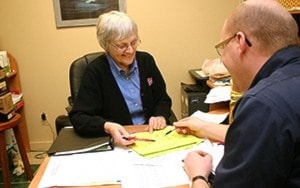With the holiday season behind us, most are looking forward to spring. But for some of the residents of Quesnel, life has a certain sameness and needs must be met even if that means a regular visit to the Salvation Army soup kitchen or food bank.
According to Lieutenant Stefan Van Schaick the largest demographics at the soup kitchen is single males between 25 – 50 years old.
“We see far fewer women in this demographic,” he said.
“And I’m not exactly sure why. Possibly they have better group support and more community support whereas men aren’t as free to ask for that kind of support.”
Regardless of the demographics Stefan said the February numbers for the soup kitchen spiked in February topping out with 160 on one day. This month they have averaged 130 per day, four times a week.
“January was between 100 – 120 per day,” he said.
He emphasized he’d rather see the same level of attendees instead of the fluctuation which happens around cheque day.
“A constant number would mean their needs are being met instead of them using their resources differently. They can always access a meal or food somewhere in town,” Stefan said.
As for the food bank, those numbers remain steady at between 100 – 120 households every two months.
Because the system is based on people registering for the food bank and divulging personal information on their situation such as family income, number in the family, rent (or mortgage) payments and other bills, their needs are clearly identified and receiving food bank groceries is part of how they cope with life.
Stefan added that about 75 per cent of soup kitchen attendees are also food bank recipients.
“People need to understand that the food bank is not supplying two months of food, it supplements regular food purchases,” he said.
“At the Salvation Army we’re trying to educate and assist individuals towards self-reliance, which can include
using the food bank, soup kitchen, etc. if needed.”
Relatively few soup kitchen attendees are homeless. In fact, Stefan estimated that only about five per cent have no fixed address.
“I don’t know of anyone having to sleep outside,” he said.
“Some couch-surf, some live with relatives, live in a travel trailer or have some inside sleeping arrangement.”
Having a fixed address is also a requirement for accessing the food bank.
Only about 10 – 15 per cent at the soup kitchen are new faces and most of those are First Nations. Stefan speculated this may be tied to the culture as First Nations travel extensively throughout the north from one community to another.
Stefan says the Salvation Army is confident going into this year.
Both the kettle campaign and the mail-in campaigns met their targets, with the kettle campaign bringing in a little more than the $30,000 goal and the mail-in exceeding the $47,000 target by about $5,000.
“We are always so amazed and grateful for the generosity of the community.
“In donations to the food bank we brought in about double our normal intake.
“It will be interesting to see how the rest of the year goes, we’ve never been in this situation before,” he said.
“In previous years, come summer, we’ve had to purchase caselots but maybe this year that money can help in other ways.”
Many people are unaware that the Salvation Army, like many organizations, must be accountable for what they do, what they hand out to those in need and how they use the donations they receive.
With all the services and programs offered, Quesnel’s Salvation Army provides valuable assistance to the community’s most vulnerable citizens.
